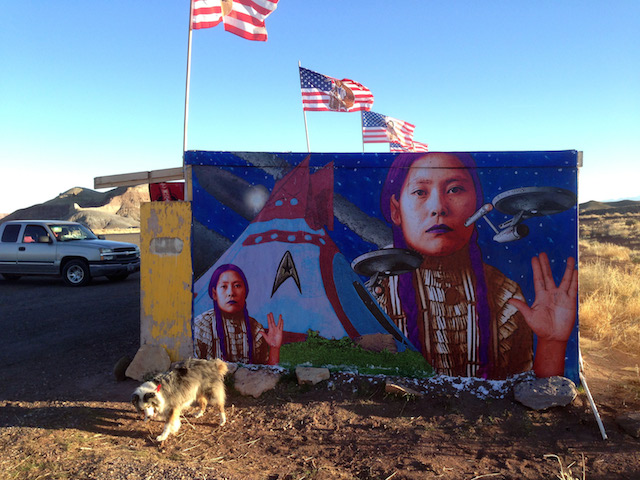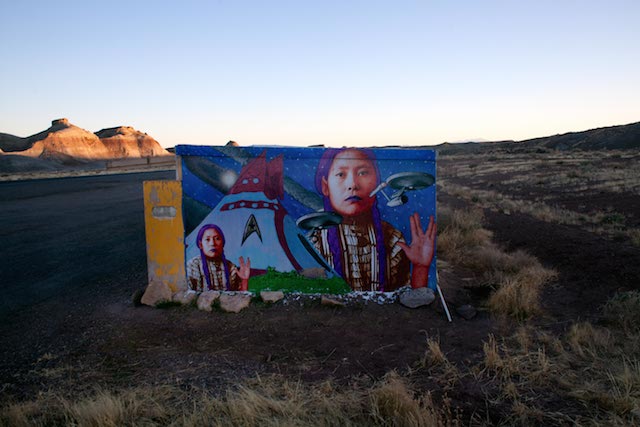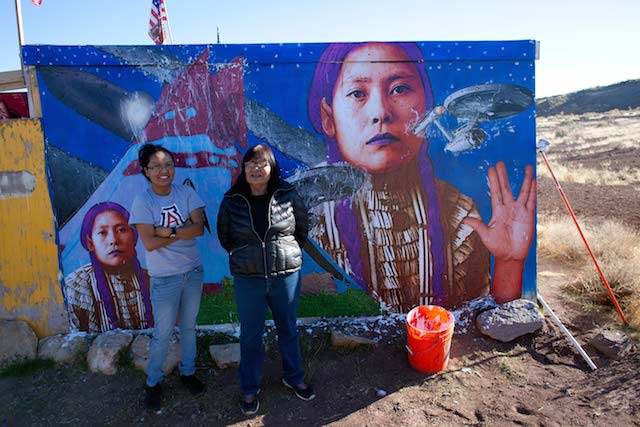
Note from the editor: I’m pleased today to have this guest post from Chip Thomas aka Jetsonorama, an artist we have covered on Vandalog many times and also the organizer of The Painted Desert Project. The most recent contributor to the project is Debra Yepa-Pappan, whose piece is shown above. Yepa-Pappan’s work is new to me, so we’re also publishing an interview that Thomas did with her. – RJ
Chip Thomas: Can you tell me a bit about yourself? Where are you from originally, how did you meet and end up in Chicago?
Debra Yepa-Pappan: I was born in Korea. My father was in the Army and was stationed in Korea where he met my mother. I was born after he had been moved back to the U.S. When I was 5 months old, my mother and I emigrated to the States to be with him. We lived in Jemez for a short time, then on the Army base with my dad in Alabama and then Mississippi, where my parents were married. By the time I was one year old, my dad was discharged from the Army and we moved to Chicago. I’ve been here ever since, although I maintain a strong connection with Jemez and my Korean side. Throughout my childhood and teen years, my parents and I would visit Jemez frequently. And I ultimately went to school at IAIA in Santa Fe to meet other Natives and to be close to “home” that being Jemez Pueblo. Chris and I met there, and I brought him back to Chicago with me when we were both done at IAIA. We’ve been together for 22 years and married for 19 years with a beautiful 12 year old daughter.
CT: What is your art training?
DYP: Growing up, I never really thought of “becoming an artist.” My interest in art started late in high school and I was focused more on design. When I attended IAIA, I began by taking jewelry and then photography. I fell in love with photography. I felt at home in the darkroom and I enjoyed the hands on process of developing my own film and prints. My instructor was Meridel Rubenstien. What I really appreciated about her was that she didn’t teach me to just be a photographer, but she taught me to be an artist. So I’ve never really thought of myself as a photographer, but an artist who uses photography as my medium. I continued on at Columbia College of Chicago where I learned to refine my darkroom skills and where I learned how to use the digital medium, but then I had to “take a break” when I became pregnant. I’m still on that break!

CT: What projects are you involved in currently?
DYP: Chris and I have work that has been traveling Russia since last year in the exhibit “Octopus Dreams.” Part of it has also been exhibited recently at 516 ARTS in Albuquerque. Chip, we saw your work there either several years ago! The exhibit will be moving on to Tokyo by this year, I believe. I recently had work at the Wing Luke Museum in Seattle in “War Baby/Love Child: Mixed Race Asian American Art”. This exhibit opened here in Chicago at the DePaul Art Museum last spring and the art is also featured in a book by the same name.
Most recently, Chris and I were in a small group show at the Hive in Phoenix called “Multi-Verse” which was curated by our friend Thomas “Breeze” Marcus. It was very well received and had a feature in Western Art Collector magazine.
Last summer, we worked on a bricolage mural here in Chicago. It was a large collaboration with artists from the Chicago Public Art Group in which Chris had the opportunity to design and paint the Native history part of the mural. Our daughter, Ji Hae, and I did the tile work around his paintings.
And upcoming, we are doing a show in Bristol, England this summer. We are currently underway with fundraising efforts.
CT: Debra – I’m curious about your mashup of traditional imagery with science fiction imagery. How did this evolve and what does it represent? What are your influences artistically and philosophically? (I notice in a lot of street art coming from Latin America and from Europe work that incorporates magical realism. It’s less commonly found in in work in the States. My guess is the references for this work come from folk tales and myths within those cultures. Your work references magical realism as well and I wonder what the references or influences are for your work.)
DYP: This is a very good question and I’m glad that is what you see in my work. All of my work is about identity, my earlier work addressing Indian stereotypes, and my more recent work about my dual heritages, both of which I’m very proud to be a part of. My mother is Korean and a Buddhist. As a child I remember going to the Korean Buddhist temple with her every week. We also visited my father’s home Jemez Pueblo often to see family and for the dances. My life had always been very rich spiritually. As diverse as my 2 cultures can be, they are also very similar philosophically and spiritually, so with my current work, I have incorporated many symbols that have significance in both cultures, often times having the same meanings. The meanings are all relevant to the characteristics of Korean and Native peoples still to this day. It’s important for me to not only share who I am, but to portray the strengths of my people.
CT: Do you consider yourself a sciences nerd?
DYP: Well, no, I don’t consider myself a “sciences nerd.” I have to admit, when I was younger I didn’t really care much for the science fiction genre. It wasn’t until I met Chris that my interest and appreciation for the genre grew. It always amazes me how ahead of their times science fiction shows, movies, novels, etc, were and are, in their use of different technologies and their inclusiveness between different races of people, humanoids, and species. I don’t know if I’ll ever become a true science nerd, but I do have a lot of respect for those who are!
CT: Your original title for this piece was the incendiary “Spock was a 1/2 breed.” Talk a little bit more about that.
DYP: The title for that image still is and will always be “Spock was a Half-Breed (Live Long and Prosper)”, but pushing “Live Long and Prosper” feels more appropriate in this case because it’s a strong and necessary message. It’s a reminder to Native peoples that we have survived and will continue to endure. We are in control of the course of our future for ourselves and our future generations.
CT: You know you rock! Thanks so much for contributing work to the Painted Desert Project and for your time with the interview. It’s an honor to have worked with you on this. All the best to you, Chris + Ji Hae.

Photos by Chip Thomas
